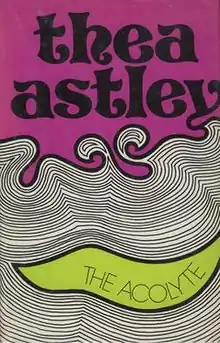 First edition | |
| Author | Thea Astley |
|---|---|
| Country | Australia |
| Language | English |
| Publisher | Angus and Robertson |
Publication date | 1972 |
| Media type | Print (Hardback & Paperback) |
| Pages | 158pp |
| ISBN | 0207124221 |
| Preceded by | A Boat Load of Home Folk |
| Followed by | A Kindness Cup |
The Acolyte is a Miles Franklin Award-winning novel by Australian author Thea Astley first published in 1972.[1]
Plot summary
The novel is told in the first person by “the acolyte,” Paul Vesper. The novel traces the career of a fictional Australian musician and composer named Jack Holberg. Beginning in obscurity as a piano player in Grogbusters, a dreary little Queensland town, the blind Holberg eventually gains international recognition as a composer. Vesper, who had met Holberg during his less renowned period, gives up an engineering career to serve the great man—in a sense, to become his eyes.
Notes
In an interview noted in The Canberra Times, Astley stated that she wrote the book partly in answer to Patrick White's The Vivisector. ""Why write only about the great, changing Christ figures?" she asked a Sydney journalist. "Why not write about the other people who share their lives?""[2]
Critical reception
After the novel had been republished in the US in 1988 Kirkus Reviews wasn't overly impressed: "In The Acolyte (1972), a failed engineer and two German sisters devote themselves, body and soul, to the whims of an egotistical blind composer. The author uses great care in dissecting the minutest variations in their orgies of self-sacrifice, but she neglects to show what it is that draws them to destruction. All three are willing doormats from the start. As a result, there is a good deal of truth in Astley's observations but very little interest. Nor are matters helped any by an ostentatiously prickly style."[3]
Writing in an overview of Astley's work in 2010 Megha Trivedi stated: "The novel carries human element of love, the frustration of Paul Vesper and his brutal reaction against the selfishness of Holberg. The Acolyte highlights the never ending personal, spiritual and artistic desires of human beings."[4]
Publishing history
After its original publication by Angus and Robertson in 1972,[5]the novel was published as follows:
- University of Queensland Press 1980, Australia[6]
- G. P. Putnam's Sons 1988, USA (as a part of Two by Astley: A Kindness Cup and the Acolyte)[1]
- Penguin Books 1990, USA[1]
- University of Queensland Press 1998, Australia[1]
- Untapped 2021, Australia[1]
See also
References
- 1 2 3 4 5 "The Acolyte by Thea Astley". Austlit. Retrieved 24 June 2023.
- ↑ "Writers' World" by Maurice Dunlevy, The Canberra Times, 21 April 1973, p10
- ↑ "Two by Astley", Kirkus Reviews, 30 May 1988
- ↑ "Thea Astley: Writing in Overpoweringly a Male Dominated Literary World" by Megha Trivedi, IRWLE, Vol6 No. II, July 2010
- ↑ "The Acolyte (Angus and Robertson)". National Library of Australia. Retrieved 23 June 2023.
- ↑ "The Acolyte (UQP)". National Library of Australia. Retrieved 23 June 2023.
External links